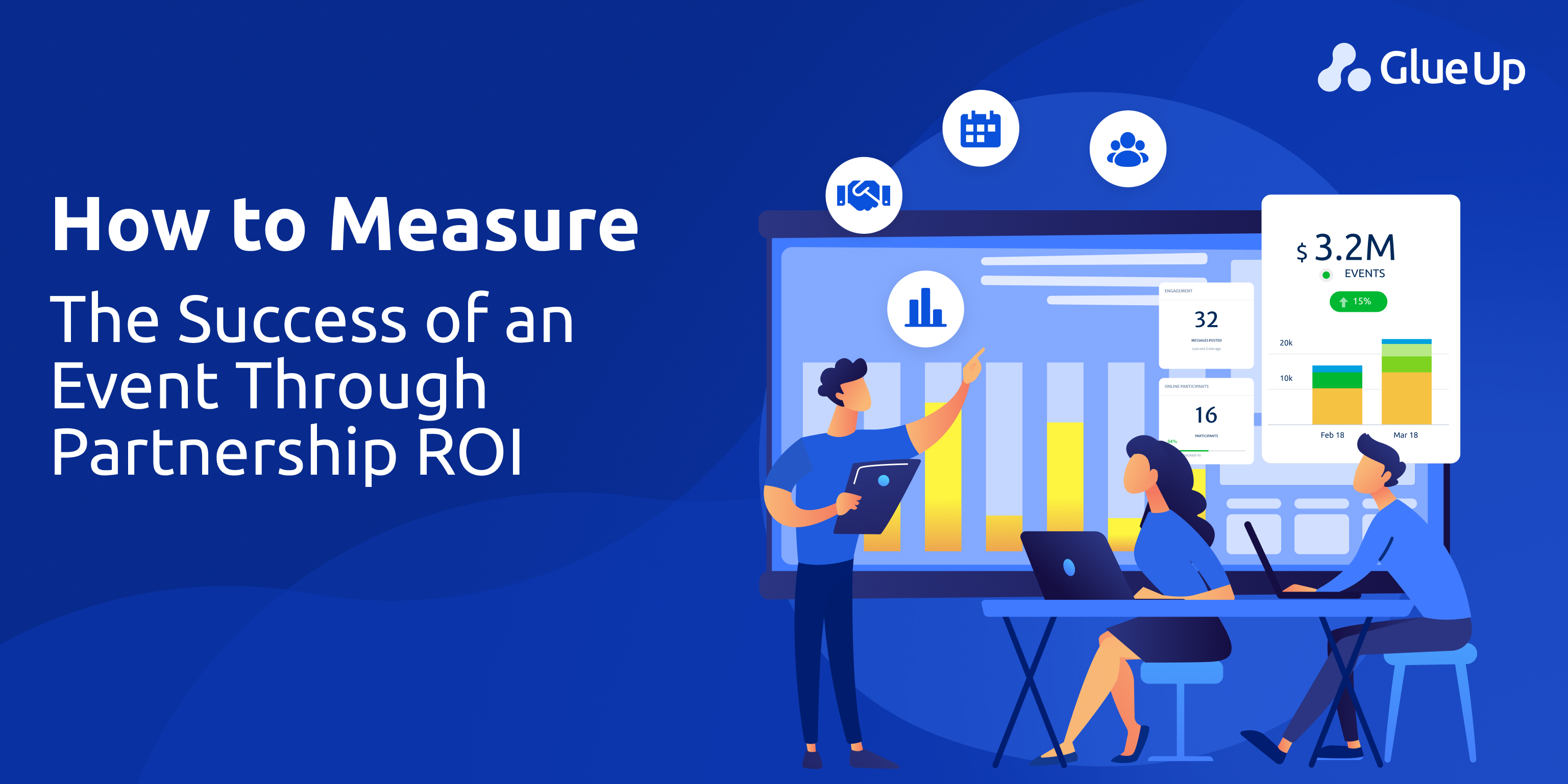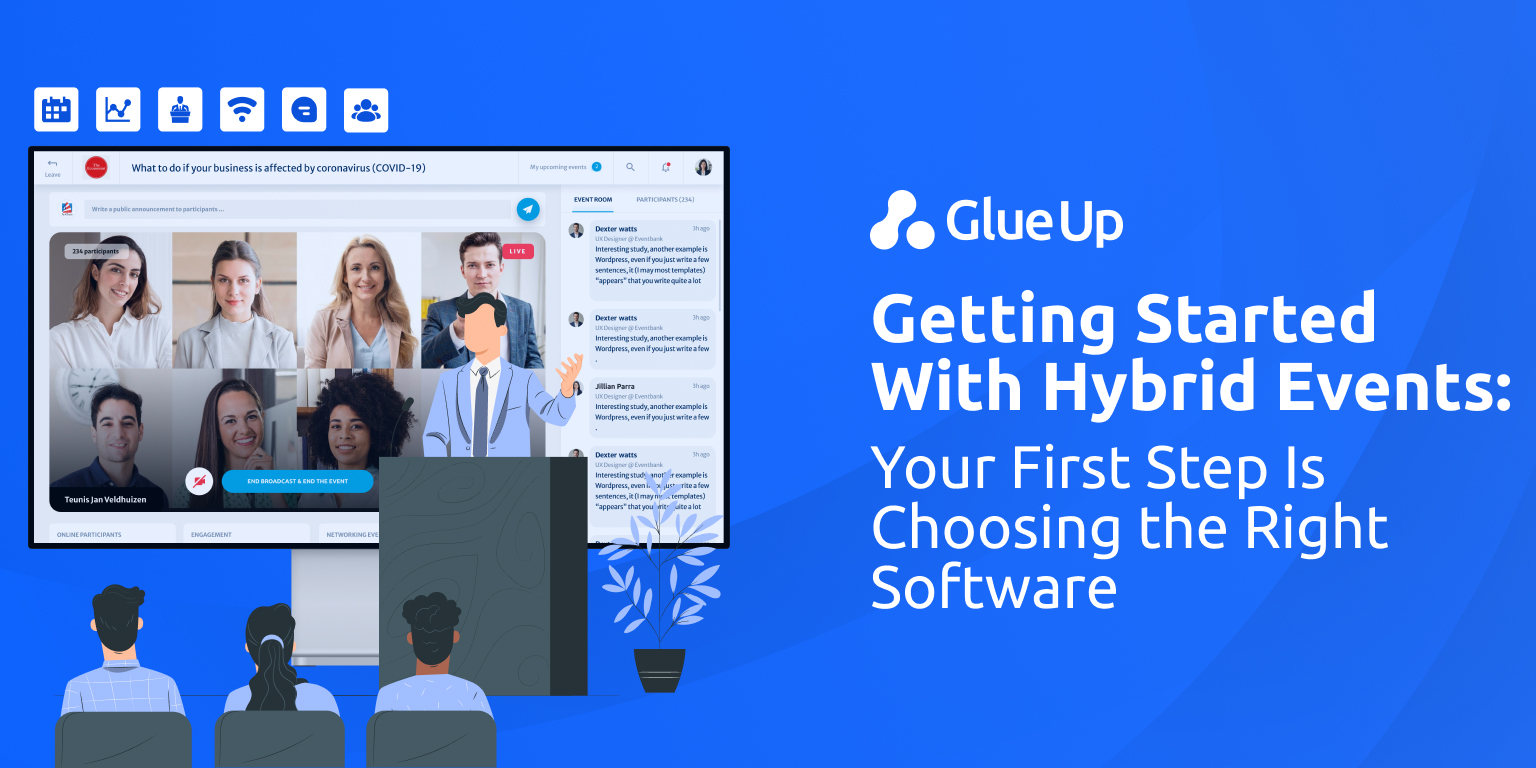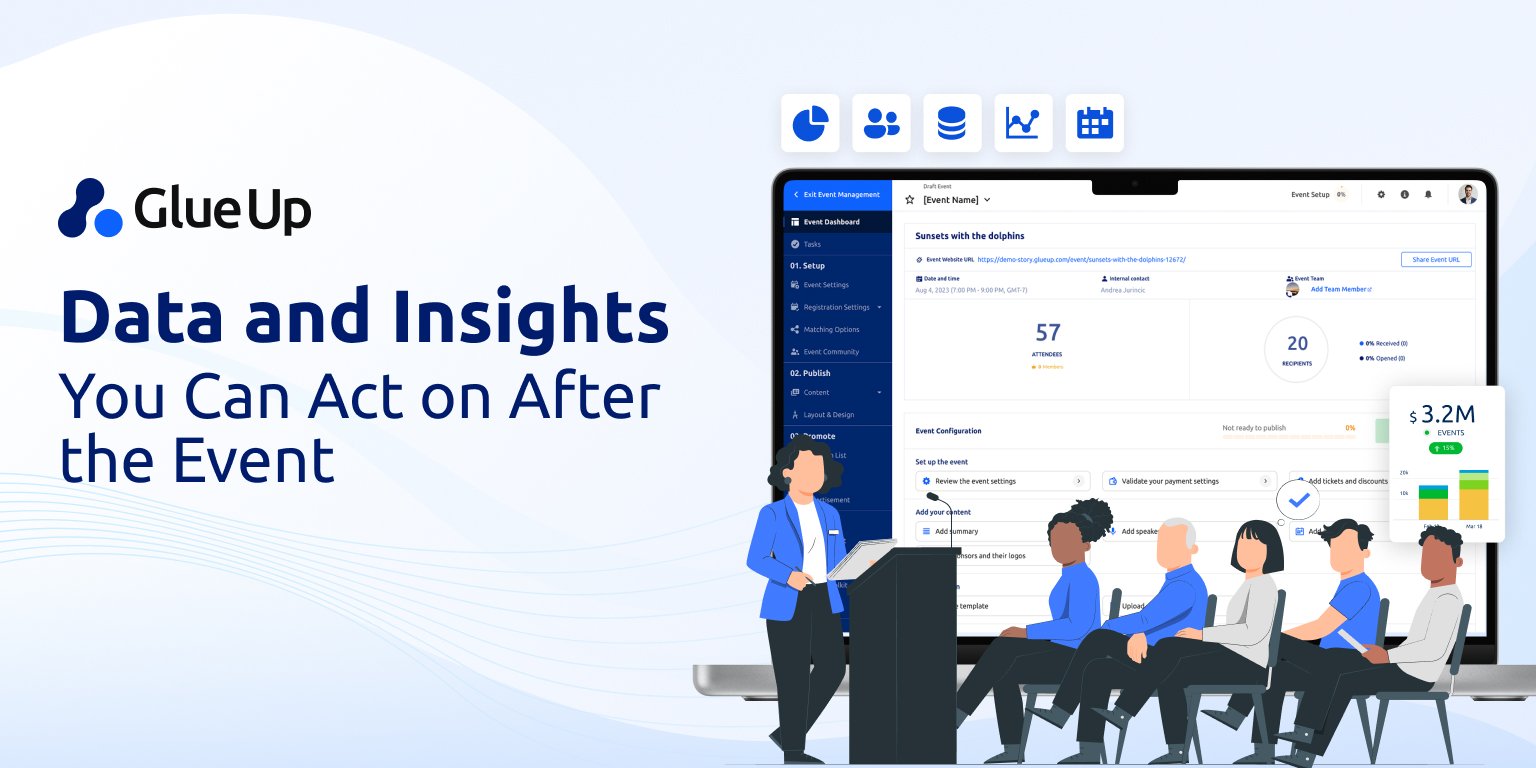
You open your renewal deck. There is a slide with attendance, photos, and quotes. Your partners smile politely, then ask the only question that matters: was it worth it. If you have wondered how to measure the success of an event, you already know the answer is not a headcount.
It is a simple, credible story that ties what people did at your event to value your board, sponsors, and members can trust. In this guide, we build that story from the ground up for associations, chambers, and member organizations using Glue Up. You will leave with a clean framework for how to measure the success of an event, a playbook to calculate partnership ROI, and ready to ship scorecards that make renewals feel like the natural next step.
Key Takeaways
Use a two-track model, always. Pair ROI (money) with ROO (objective attainment). Sponsors renew when you show both cash impact and goal delivery, on one scorecard with weights and owners.
Plan the win before day one. Write measurable outcomes into sponsor agreements, pick 5–7 KPIs, set weights, and tag data in Glue Up (roles, target accounts, sessions, sponsor touchpoints) before registration opens.
Measure behaviors. Track actions that signal intent: watch time, Q and A, polls, meetings, demos, and social share of voice, and tie them to opportunities and pipeline in Glue Up’s Membership CRM.
Report fast, with CFO-clean math. Within 10 days, send a one-pager with ROI, ROO score, deliverables hit rate, highlights, and a single “next-time” change. At 30, 60, and 90 days, add weighted pipeline and renewal readiness.
Improve in cycles. Raise the numerator (better conversion, better audience mix) or lower the denominator (smarter costs), log each experiment, clone what works in Glue Up, and make renewals a review, not a debate.
Quick Reads
How to Measure the Success of an Event the Two Track Model
When leaders ask how to measure the success of an event, they are asking for proof. Proof that your sponsors reached the right people. Proof that your programming moved members to act. Proof that next year should be bigger or smarter. The best way to provide that proof is a two track model that pairs ROI and ROO.
ROI is financial value. It is the money side. Think opportunities created, revenue influenced, sponsorship cash, exhibitor fees, and any media value you can audit with confidence.
ROO is return on objectives. It is the objective side. Think target accounts reached, meetings booked, speaking slots delivered, share of voice, and sentiment lift.
You will present both. The board cares about ROI. Your partners often care about both. Your members care about outcomes that touch their work. Glue Up helps you set targets, capture behaviors during the event, and report outcomes with a single source of truth.
Mini glossary to align your team
Attendance conversion = attendees divided by registrants
Meeting yield = meetings scheduled divided by scans or conversations
Opportunity rate = opportunities created divided by meetings
Weighted pipeline = sum of opportunity value times stage probability
Event ROI = gross value minus total cost, divided by total cost
ROO score on a ten point scale = sum of objective weight times attainment
You can run the entire model in Glue Up using Event Management, Membership CRM, Community, Mobile Apps, and AI Copilot to package reports.
How to Measure the Success of an Event Before It Happens
Events fail or succeed during planning. The single biggest mistake is vague goals. Fix that with three moves.
Write measurable outcomes into agreements
Every sponsor package should have a success section. Keep it short and concrete.
Speaking slot delivered with session attendance target
Target account reach among named companies and roles
Meeting target with qualified attendees
Branded content views with a quality threshold
Introductions to named accounts or committees
Add a reporting cadence. Agree to a mid event pulse and a final readout date. Glue Up stores these commitments alongside the event and account records so everyone can see what matters.
Pick a compact scorecard and weight it
Choose five to seven KPIs that match what you promised. Assign weights that reflect priorities. Example weights for a partner theater session:
Session attendance, 15 percent
Average watch time, 15 percent
Questions asked, 10 percent
Meetings scheduled, 25 percent
Opportunities created within 30 days, 25 percent
Visual share of voice, 10 percent
This creates a single ROO score that anyone can scan. It also teaches your team what to maximize on site.
Tag the data now
Decide what you will tag before registration opens. That is your data discipline. In Glue Up, confirm fields for buyer role, company tier, member status, target account flag, sponsor name, and session. Use consistent picklists. Create smart lists that pull these segments, so your dashboards are ready the moment people register. If you need only one habit, make it this one.
How to Measure the Success of an Event While It Is Live
Think of your live days as a factory floor for proof. Capture behaviors that signal intent, not just bodies in seats.
Engagement signals to capture
Attendance rate by session and by role
Average watch time or time in room
Q and A volume and quality themes
Poll response rate and response mix
Meetings scheduled and who is in the room
Dwell time at booths and demo notes
Mobile app activity such as favorites, agenda saves, and messages
Glue Up check in tools, session analytics, and mobile polls make this simple. Set up on site QR codes for micro surveys. Keep each micro survey to one or two questions. Offer a small value exchange like early access to slides or a raffle to lift completion.
Social signals your sponsors notice
Branded hashtag posts and unique authors
Mentions of sponsor handles
Share of voice against peer brands
Clicks to sponsor pages and resource hubs
Plan your campaign tag in advance. Share it with speakers and sponsors. Display it on screens. Assign one person to collect top posts during the event. Those posts will feature in your partner report.
Quality over volume
Exposure is not a finish line. Tie exposures to actions. Examples that move renewals:
View to scan to demo
Session attendance to meeting
Meeting to opportunity within 30 days
Glue Up lets you record scans, attach notes, and sync to the Membership CRM, so your live team can focus on conversations while the system captures context.
How to Measure the Success of an Event After It Ends
The clock starts when the lights go down. Speed signals professionalism.
Run a three-stage survey plan
Within 24 hours ask about satisfaction, speaker quality, relevance, and one next step
At seven days ask about action taken, such as a download or outreach
At thirty days ask about outcomes, such as a demo scheduled or a policy change at work
Keep each survey short. Three to five questions max. Use Glue Up branded forms with skip logic so people only see what applies to them. Capture sponsor recall with an unaided question first, then an aided list.
Produce a partner report your CFO would sign
One page is ideal. Two pages if you must. Use this structure.
The goals you set with the sponsor
What you delivered against each goal
Highlights with photos or quotes
Numbers that matter ROI, ROO score, meetings, opportunities, weighted pipeline, share of voice
What we will improve next time with a single change that increases impact
Attach an appendix with raw tables for teams that want detail. Decision makers will read the one-page overview.
Close the loop on pipeline and renewal
Marketing and events do not close deals, but you can show how your event set the stage. In Glue Up, pull a 30, 60, and 90 day pipeline snapshot for opportunities tied to scans, meetings, or sessions. Show meeting to opportunity rate and weighted value. Pair that with a renewal readiness call for each sponsor. You will walk into renewal talks with firm ground under your feet.
How to Calculate Sponsorship ROI Effectively
Money talk should be plain. Use a simple formula and clear rules.
The formula
Event ROI = gross value minus total cost, divided by total cost
What belongs in gross value
Closed won revenue within your agreed window
Weighted pipeline that stems from the event, with stage-based probabilities documented
Sponsorship cash and exhibitor fees
Media value that passes an audit standard you share in advance
Guardrails to keep the math clean
Do not count impressions alone as value
Do not count pipeline at full face value
Do not extend your window to chase credit
A simple example you can customize
Total cost: 120 K
Sponsorship cash: 80 K
Closed won within 90 days tied to event: 140 K
Weighted pipeline at 40 percent probability: 200 K times 0.4 equals 80 K
Gross value: 80 K plus 140 K plus 80 K equals 300 K
ROI: 300 K minus 120 K equals 180 K, divided by 120 K equals 1.5, or 150 percent
If partners need brand lift counted, include a media section that cites an agreed method, then show ROI with and without media value. That keeps trust intact.
Event Engagement Metrics and Event KPIs That Move Renewals
Vanity metrics have their place in press releases. Use three tiers that align with real decisions.
Baseline KPIs
Registrations and attendance
No show rate
Average watch time per session
Session feedback score
Business KPIs
Meetings scheduled and kept
Meeting to opportunity rate
Opportunity value and stage mix
Time to first meeting after the event
Partner KPIs
Sponsor deliverables hit rate
Target accounts reached and engaged
Visual share of voice in recorded content
Sponsor NPS and renewal likelihood
Place your five to seven chosen KPIs into the weighted scorecard you wrote before the event. That scorecard becomes your ROO number on the front page of the partner report.
What Are the Key Metrics for Measuring Partnership Success
Partners buy three outcomes. Reach, engagement, and business impact. Measure each with clarity.
Reach
Unique attendees in the right roles
Share of voice for the brand and speaker
Traffic to a sponsor resource page
Engagement
Session dwell and questions
Content downloads and saves
On site demos and offers redeemed
Business impact
Meetings and introductions to named accounts
Opportunities created and value
Renewal propensity or expansion discussions
Present these in a simple table. One column for the target, one for the actual, one for the delta, and one for your plan to raise the number next time.
What Tools Can Help Track Event Partnership Impacts
You need a system that connects registration, engagement, and outcomes. You also need simple ways to collect feedback and social signals.
Glue Up Event Management tracks registration sources, check in, session analytics, dwell, and meetings
Glue Up Membership CRM records contact roles, account tags, opportunities, and weighted pipeline
Glue Up Mobile Apps capture polls, Q and A, survey prompts, and push reminders
Glue Up Community extends the conversation, hosts sponsor content, and reaches members between events
Social listening and analytics report mentions, sentiment, and share of voice. Export charts into your partner report
Glue Up AI Copilot helps in drafting partner recaps, compiles highlights, and creates post event outreach based on real numbers
When teams use one environment, you avoid the copy paste errors that make sponsors question the story.
How to Improve ROI for Future Event Collaborations
Improvement is a cycle. Document change like a scientist.
Two levers
Raise the numerator. Better conversion from scans to meetings. Better conversion from meetings to opportunities. Better target account mix.
Lower the denominator. Smarter production choices. Smaller venue for the same impact. Shorter program that increases focus.
Experiment log
Pick one or two variables per event. Change the speaking order. Switch the call to action on a theater session. Offer a meeting concierge service. Run a new format for a sponsor demo. Measure each change, then decide what to keep. Glue Up lets you clone events and carry your scorecards forward, so experiments become a practice, not a one off.
Common Challenges in Measuring Partnership Success Solved
No goals written down: Fix it with a sponsor success addendum that lists the two or three outcomes that matter.
Engagement tracked but not attributed: Fix it with tag discipline. Assign one owner before the event who checks fields daily.
Exposure celebrated while actions ignored: Fix it with action first KPIs like meetings, demos, and opportunities.
Thin survey data: Fix it with short, well-timed prompts and on-site capture via QR or tablets.
Data lives in silos: Fix it with Glue Up as your system of record, where events, members, and sponsors live together.
How to Measure the Success of an Event in the Workplace
Member organizations also run internal events. Treat them with the same respect.
Reach and participation: Live attendance, replay views, and average watch time by department and location.
Understanding: Three question comprehension quiz. Poll on clarity. Open text on what needs follow up.
Action: Sign-ups for benefits, training, or programs. Policy acknowledgments. Resource downloads.
Follow through: Manager cascade completion. Questions answered within service targets. Engagement on follow up posts in Community.
Glue Up covers registration, live engagement, surveys, and the follow up messages that close the loop. Use the same partner style report for your executives. It shows discipline and earns trust.
Evaluation of an Event Example
Use this quick example for a sponsor theater session at an annual meeting.
Objectives
Reach 50 target accounts with manager or director roles
Achieve average watch time of 20 minutes
Generate 40 meetings at the demo bar
Create 10 qualified opportunities in 30 days
Reach visual share of voice of at least 8 percent in the recorded session
Results
Reached 62 target accounts
Achieved watch time of 23 minutes
Ran 44 meetings
Created 9 opportunities within 30 days and 4 more by day 45
Achieved visual share of voice of 9.4 percent
ROI and ROO
ROI with cash and weighted pipeline produced 140 percent
ROO score on weighted objectives produced 8.6 out of 10
Next time plan
Pre book five meetings with named accounts
Add a call-to-action slide at minute eight
Invite a customer voice to the session
Event Evaluation Plan Example
Copy this structure into a one-page template and store a blank inside Glue Up so every event begins with clarity.
Objectives: List the three outcomes that matter most. Make each measurable.
KPIs and weights: Choose five to seven numbers. Assign weights that sum to one hundred.
Data sources: Registration, check in, session analytics, mobile polls, scans, meetings, CRM, post event surveys, social listening.
Owners: Assign a name to each KPI. You will know who to ask during the event.
Cadence: Set live check in windows and reporting dates. Include a mid-event pulse, a ten-day partner draft, and a thirty-day pipeline snapshot.
Deliverables: Sponsor report, internal debrief, scorecard file, and experiment log.
Event KPI Examples You Can Lift
Annual meeting
Attendance rate of at least 75 percent
Average time in session of at least 22 minutes
Sixty target accounts reached
Forty meetings scheduled
Meeting to opportunity rate of at least 25 percent
Sponsor town hall
Share of voice of at least 8 percent
Twelve questions in Q and A
Fifteen demos
Six qualified opportunities in 30 days
Workplace town hall
Eighty percent live reach
Seventy percent correct on the quiz
Twenty percent click through to benefits portal in seven days
What Are the Most Effective Tools for Tracking Event Metrics
Track where people came from, what they did, and what happened next. That is the whole job.
Registration and check in are in Glue Up Event Management
Engagement and meetings flow into session analytics and notes
Opportunities and revenue live in Glue Up Membership CRM
Social listening tools feed mentions and share of voice into your appendix
Surveys and polls live in Glue Up forms and Mobile Apps
Reporting is packaged with Glue Up AI Copilot and exported as a PDF or shared page
One place to set goals and one place to read results is the quiet secret behind every strong renewal.
How Can Social Media Engagement Indicate Event Success
Social is a proxy for reach and relevance beyond the room. Make it concrete.
Plan one unique campaign tag
Publish a short guide for speakers and sponsors to use it
Measure unique authors, quality of mentions, and clicks to sponsor pages
Pair social signals with actions. A spike in posts during a session should correlate with questions, sign ups, or downloads
Sponsors care when social moments drive people to do something. Show the link. Glue Up Community can host follow up content from sponsors and track who engages after the event.
What Key KPIs Should Be Set Before Planning an Event
Set targets that match your event type and your revenue model.
For member growth: Registrations from non-members, trial sign-ups, conversion to paid within ninety days.
For sponsor success: Target account reach, speaking slot attendance, meetings, opportunities, renewal readiness.
For education and policy: Comprehension, intent to act, compliance steps completed, feedback sentiment.
Write each KPI with a clear owner, a realistic target, and a single data source. If a number depends on three systems, pick a different number.
How to Analyze Post Event Feedback for Improvement
Feedback is only useful when you tie it to a change. Treat it like a user study.
Segment responses by member tier, role, and target account status
Map open text to themes such as content relevance, logistics, and partner visibility
Assign one change to each theme for the next event
Publish a short you said we did note in Community to close the loop
Glue Up forms and Community make this fast. You will also set a tone that earns responses next time because people can see that feedback matters.
What Financial Measures Best Evaluate an Event Success
Finance leaders want simple numbers that compare across events.
Cost per attendee qualified, not just total
Cost per meeting
Cost per opportunity
Event ROI with clear inclusions
Sponsor renewal rate across your portfolio
Sponsor lifetime value if you have a multi year pattern
Track these the same way each time. Publish a small glossary in your sponsor prospectus so everyone uses the same language.
Putting It All Together Inside Glue Up
Here is the clean, repeatable plan you can run every quarter.
Fourteen days before: Lock KPIs, weights, and owners. Confirm tags and smart lists. Create the partner report shell with AI Copilot.
Event week: Monitor session attendance and watch time. Track meetings and dwell. Collect top social posts. Push a one question pulse at the end of day one.
Ten days after: Send the partner report with ROI, ROO score, engagement highlights, and a clear next time change. Include a short note on how the sponsor can collaborate with content in Community.
Thirty days after: Share the pipeline snapshot. Confirm renewal readiness. Propose the next program with a simple change that raises the numerator or lowers the denominator.
A Final Word You Can Say Out Loud
You asked how to measure the success of an event. Now you have a model you can run every time. It is simple on purpose. Set the goals in writing. Capture behaviors that show intent. Tie those behaviors to opportunities and renewal. Tell the story in one page, then show your math. Do this and partners will stop asking if it was worth it. They will ask where to sign.
Glue Up gives you the parts you need to make that story true. Events. CRM. Mobile. Community. AI to package the work. Put them together, and how to measure the success of an event stops being a question at the end of your deck. It becomes the plan you lead with.
Ready to raise your next report. Book a demo today and discover how Glue Up integrations can optimize your workflows.



